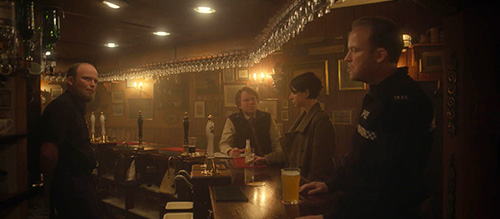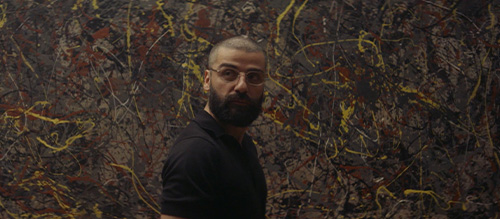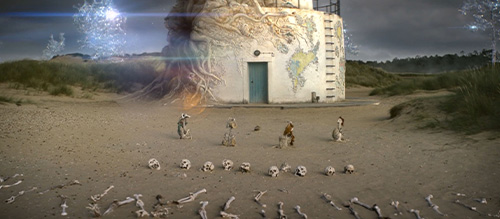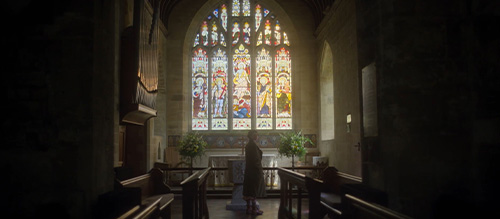Making Sense of Alex Garland’s ‘Men’

Please note that this article contains spoilers for the films Men, Annihilation, and Ex Machina.
On its most basic level, Alex Garland’s newest movie, Men, tells a fairly simple story. Jessie Buckley plays Harper, a woman whose husband James (Paapa Essiedu) has recently died. This happened while they were in the process of divorcing (on her initiative, not his): during one of their arguments, James struck Harper, and she kicked him out of their apartment. James then slipped and fell to his death while trying to break back in. Now, Harper isn’t sure whether James merely slipped (it was raining) or whether he “let himself go,” as she puts it, since he’d already threatened to kill himself if she went through with the divorce. (He also said that he would haunt her, and that she would have to live with his death on her conscience). With all of these thoughts weighing heavily on her mind, Harper leaves London, looking to get away for a couple of weeks in order to find some measure of peace. But James’s ghost continues haunting her (as tends to happen in Gothic horror stories, which Men explicitly invokes), and the young widow winds up experiencing a long night of the soul, at the end of which she directly confronts James’s spirit. The film then ends somewhat ambiguously, though I think we’re meant to believe that Harper has found the peace she’s been seeking (but more about that below).
Part of what makes Men an unusual film is that, while its story may be simple, its presentation isn’t; rather, it plays out like various European art films of the 1960s and ’70s. Watching it, I was reminded of movies such as Repulsion, Persona, Hour of the Wolf, Suspiria, and Possession. I was also reminded of Andrei Tarkovsky’s work in general, and if Annihilation was Garland’s response to Tarkovsky’s Stalker, Men would seem his response to that man’s other science-fiction movie, Solaris (which features a dead spouse who keeps returning). A lot of what we see onscreen isn’t always literal, the movie’s events being filtered through Harper’s perspective. Garland also makes extensive use of associative editing, periodically interrupting the story with flurries of other images. (For example, when Harper sits down to play the piano, Garland cuts to shots of nature, which we’re meant to associate with Harper’s music; they may even represent what Harper is thinking about while she plays.)
And that’s not all. Complicating both these elements is the fact that Men does something unusual with its casting: all of the men in the village where Harper is staying appear to be the same man, or at least strongly resemble one another. That’s because all of the men that Harper encounters—her landlord Geoffrey, a cop, a petulant little boy, the local vicar, the pubkeeper and his two customers—are played by the same actor, Rory Kinnear, a feat accomplished through costumes and make-up, and a little CGI. On the one hand, this aspect of the film is something of a sly joke, a droll observation of how in some small towns, everyone looks the same because they’re related, and we should remember here that what we’re seeing is from Harper’s point of view. (This is another way in which the Irish Harper is made to feel out of sorts, since she’s the outsider, both to the countryside and the country.)

But Garland is up to more than just that. Each of the characters that Kinnear plays represents a different aspect of patriarchy, or institutionalized male authority; in that way, they are, on a structural level at least, all aspects of the same otherwise invisible cultural force. Harper, whose relationship with her husband was fraught to say the least —flashbacks show him alternately pleading with her, threatening her, warning her, striking her—can’t find respite in the village because, wherever she goes, she finds reflected back to her on a larger, societal level all the same problems that she experienced in the waning days of her marriage. (Other elements of the countryside also trigger strong memories—e.g., dandelion spores drifting through the air recall the dust motes that were swirling around her apartment at the time her husband died.) To put this point another way, while the men that Harper encounters in the village aren’t the same person, and aren’t the same person as her husband, they’re all products of the same system that birthed James (and her), and the grieving Harper sees all these men as embodying, individually and collectively, the same manipulative behaviors that James manifested during her time with him. (This is true regardless of whether the character is gently and unintentionally patronizing, as is Geoffrey, or downright sadistic and cruel, as is the young boy who curses out Harper when she refuses to join him for a game of hide-and-seek.) Harper experiences all of these encounters as an accumulating series of intrusions and disturbances, even as others try to tell her that nothing worrisome is happening (e.g., a female police officer dismisses the naked homeless man who trespassed at her house as being harmless), and their collective emotional burden intensifies until, by the end of the long night, she concludes that there really is no escape from James’s ghost. (As she says early on to her friend, “this sort of thing is going to keep happening for the rest of my life.”) This realization leads her to directly confront her memory of the man, in an attempt to learn what she must do in order to lay his spirit to rest.
But that still only scratches the surface of what Garland’s doing here, because he is using the genre of the Gothic horror film, the formal devices of the European art film, and the theme of patriarchy to explore one of his favorite concepts, which is what’s known in philosophy as “the problem of other minds.” Put very simply, this is the problem that there’s no way for any of us to tell whether other people have minds similar to ours, capable of thinking and feeling the same way that our minds do. (Related to this is the problem that there’s no way for us to empirically prove that the world is actually real, and we aren’t instead programs running in a computer simulation, or as older philosophers put it, ideas in the mind of God.) All three of the films that Garland has directed revolve around some version of this problem. In Ex Machina, Oscar Isaac’s Nathan invites Domhnall Gleeson’s Caleb to his home in order to help him judge whether or not the A.I. that he’s created, Ava (played by Alicia Vikander) is self-aware, or merely a clever computer program that’s pretending to be self-aware. In Annihilation, husband and wife Lena and Kane (played by Natalie Portman and Oscar Isaac, respectively) reunite after having ventured inside an alien phenomenon known as “the Shimmer” (which refracts information the same way a prism does light), only to wonder if they’re still themselves, or whether they’re both now duplicates, clones produced by the alien. (They also aren’t sure whether the alien is self-aware, working according to an intelligent design, or mindless, the way that nature is mindless, acting according to happenstance.) In Men, Harper’s most immediate problem is that she’s unsure what to make of her husband’s behavior (almost as though he were an A.I. or an alien entity): was he a lying, manipulative bastard who would say anything to prevent her from divorcing him (and who did in fact kill himself, just as he threatened he would), or was he sincere, a troubled and unstable person who nonetheless wanted to save their marriage (and who slipped, accidentally falling)? At the end of the film, Harper confronts James’s ghost head-on, asking him what he wants, to which he replies, “Your love.” But even this answer isn’t clarifying, due to the problem of other minds: has the ghost returned in order to speak the truth? Or is this yet another attempt by James to manipulate the woman he’s been haunting?

The problem here, as Garland knows full well, is that there really isn’t any way to tell (which is why other minds are a problem in philosophy). And I don’t think that Garland is trying to solve this problem via his films so much as he’s representing how this dilemma manifests itself not only in things like A.I. research and marriages and patriarchy (and other cultural institutions), but also in art. (Garland is the product of a family of scientists and artists, and I assume he’s fascinated by how both art and science wrestle with alternate versions of this problem). Accordingly, each of his three directorial efforts see Garland seizing on a central artistic image that embodies the problem of other minds, and which functions as a metaphor for the whole film—that stands in for the film in miniature, so to speak. In Ex Machina, this image is the Jackson Pollock painting that Nathan keeps hanging in his home; Nathan asks Caleb whether he thinks Pollock produced the painting by accident, just flinging paint at random, or whether the man was in full control of what he was doing as he dripped paint on the canvas (as Nathan claims that Pollock was). In Annihilation, the image is the invading alien entity, the Shimmer, which is certainly up to something, rearranging nature in unsettling, unusual ways, but whose true intention (if any) is difficult to discern; is the Shimmer, like Pollock, self-aware and in control of what it’s doing, making something deliberate? Or is it all just one big accident, an alternate natural logic, a mindless entity that’s invaded our own like a virus, refracting and warping the landscape willy-nilly, spreading wherever it can?

In Men, the central image that unites art with the problem of other minds, as well as Harper and James’ individual marital problem with the broader institution of patriarchy, is the baptismal font that Harper encounters in the village church, and which then recurs throughout the film (appearing at various places and times, including at one point in Harper’s London apartment). That stone basin is adorned on opposite sides with two different but related pagan fertility symbols: its Western side is inscribed with an image of the Green Man, a being who’s essentially half-man, half-plant, and who is perhaps best known today from his appearance in Sir Gawain and the Green Knight (which just formed the basis of another A24 film), while its Eastern side bears an image of the Sheela Na Gig, a woman who is holding open her vulva. The Sheela Na Gig is less well known than the Green Man, presumably because people throughout the ages have considered that image more obscene—and Garland is clearly interested here in why the Green Man has become the more dominant of the two.

The Green Man / Sheela Na Gig pairing recurs throughout Men (it really is the movie’s central image), and we should note how the icons on the stone are facing away from one another, peering in opposite directions. Perhaps as a result of that, the relationship between the two figures turns out to be unequal in the movie, with the male figure usually dominating the female. Even in the church, the Green Man icon is positioned to face the celebrants, with the Sheela Na Gig turned away from them and hidden (seen by only the vicar). And even before Harper stumbles upon the baptismal font, she goes for a walk in the woods, where she encounters a former railway tunnel, a large stone hole cut through nature that resembles the pagan stone. Harper enters the tunnel and starts singing, using the space to construct a song (another unification of science and art). But in doing so, she disturbs a naked homeless man, who is lying at the opposite end of the tunnel. That man, which the film associates with the Green Man (he’s later seen adorning himself with leaves) lurches to his feet, then starts running down the tunnel toward Harper, shouting, forcing her to retreat. And this is but one example; throughout the film, Harper finds herself on the opposite side of structures—windows, doors—from men who are peering at her, reaching for her, struggling to break in. Even the film itself is bookended by two versions of the same folk song, “Love,” written by Lesley Duncan, and while she sings the first version that we hear, as Harper drives out of London, it’s Elton John’s cover that plays over the closing credits (and is the version that follows us as we exit, humming).
Part of what Garland is doing here is pointing out how when Christianity arrived in the British Isles, it appropriated and repurposed pagan concepts like the Green Man and Sheela Na Gig; like a religious version of the Shimmer, the early Church absorbed and rearranged those icons into the story of Christ’s death and resurrection, refashioning them into a new artwork and cultural institution. (That’s why the stained glass window of Christ looms over the pagan stone in the church, bathing it in its “miraculous” light every morning.) The Church also privileged the Green Man over the Sheela Na Gig (being a patriarchal institution). Accordingly, Christ and the Green Man become bound up over the course of Men: when James dies, one of his arms becomes impaled on a fence spike, recalling the Crucifixion, and the man’s wounds later appear on the Green Man, and all of the men in the film. Watching the movie, I couldn’t help but think about how there are more than a few Green Man icons in the vicinity of my apartment, just like there are more than a few Christian churches; meanwhile, the Sheela Na Gig has slipped into relative obscurity.
Given the strong thematic connections between Alex Garland’s films, we should read the ending of Men in light of the endings of his other works. In Ex Machina, is Ava truly self-aware? In Annihilation, are Lena and Kane still themselves, or clones who can’t tell the difference? We can’t say; the problem of other minds defeats us. In the case of Men, we see that Harper has survived her long night of the soul, her encounter with the ghost; she also seems to have found the peace that she came to the countryside seeking. Certainly, the closing imagery is idyllic, Gothic horror giving way to the pastoral: the flowers surrounding Harper have all transformed from blue to pink, matching the clothing she wears throughout the film, and she’s smiling as she holds up and studies a leaf, a fragment of the Green Man. Perhaps the Sheela Na Gig has reasserted herself, dominating the Green Man? Or perhaps those two forces have been put back into balance? Or maybe Harper has merely chosen to deceive herself, submitting to James’s last lie? Whatever the case may be, we can’t really say; only Harper knows what she’s thinking.
Written by A. D. Jameson

